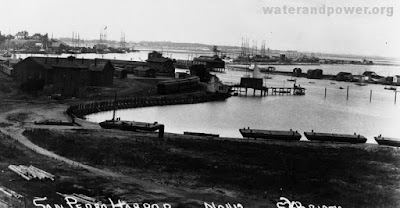 |
| San Pedro Harbor, circa 1890. (Courtesy WaterAndPower.org) |
In May 1891, a mysterious man with a gunshot wound was found dead on the shore at Shell Beach -- now called Huntington Beach. It was the first time that sparsely inhabited corner of Orange County made the newspapers in any significant way, and the details of the story inspire head-scratching.
Visitors to today's Huntington Beach were so few in that era that it took days for anyone to notice the body lying in the surf. It was discovered late in the day on May 14th, and a message was sent to Orange County Sheriff Theo Lacy the following morning. Upon arrival, it was found that the dead man had a large bullet hole in his head. By later that same day, the body was in Anaheim, undergoing an autopsy by Coroner (and future Santa Ana mayor) Frank Ey.
According to the Los Angeles Herald, "The deceased, when examined, had no air in the lungs whatever, one of the surest signs that dissolution must have taken place before the body reached the water."
The following day, the Los Angeles Times reported the man was "about 55 years of age. He had gray hair and whiskers, the latter trimmed close to the face. His weight was about one hundred and seventy pounds. The body was dressed in a blue suit of clothes and checked shirt. The hole in the head was made by a large-sized bullet, probably a Winchester Rifle ball. There was $65 on the body when it was found. The money was securely sewed with a fine wire in the pocket of the pants and so secreted as to have almost been overlooked by the Coroner. There is no clew as to the circumstances of the death or identity of the deceased."
 |
| Orange County Coroner Frank Ey. (Courtesy First American Corp) |
In fact, the body was that of David Crockett, a baker with a hazy past.
Around May fourth Crockett had arrived in San Pedro from Los Angeles and checked in at Proche's Hotel & Restaurant. He said he was from Sacramento, but that his relatives lived in Springfield, Illinois. While in town, he idled about and unsuccessfully searched for someone willing write out his will for him. Finding no takers, he returned to Los Angeles.
On May 9th, he returned to San Pedro, went into a bank, and drew out an amount of cash. That evening, he asked a hotel clerk if she would write his will for him. When she refused, he said she would soon discover why he'd made the request. Hours later, Crockett's hat and coat (with about $6 left in the pockets) were found abandoned on a pile of lumber on the San Pedro Lumber Company wharf.
San Pedro locals presumed he had killed himself. Once in the water, unusually strong tides that night would have pulled him past Smith's Island and out of the bay. The usual down-coast currents could easily have carried him to Shell Beach.
Less than a week later, Orange County, Sheriff Lacy and Santa Ana Constable Jack Landell were investigating their mystery victim, absolutely confident they had a case of homicide on their hands. They didn't make their suspicions public immediately, not wanting to tip off the killer. Soon, they were on the trail of a man who had been on Smith's Island (just inside the entrance to San Pedro Bay), but who had left by boat about the same time as Crockett's disappearance.
 |
| Orange County Sheriff Theophilus “Theo” Lacy |
Meanwhile photographs of the dead man were distributed around Southern California. Soon, a positive identification was made.
Now the San Pedro authorities had a body to go with their supposed suicide. Likewise, the Orange County authorities switched tracks completely, dropped their murder investigation, and adopted the suicide theory wholeheartedly.
But more than 120 years later, some of the facts still don't jibe.
Perhaps the missing rifle and bullet ended up at the bottom of the bay. But how likely is it that Crockett shot himself in the head with a Winchester rifle? Not only would that be fairly awkward, but one would think the lengthy news articles concerning his suspected suicide would have made mention of him owning, buying, or carrying a hard-to-conceal rifle.
And where did the gun and bullet go? Into the bay?
More importantly, how could a man die from a gunshot on a wharf, have time for all the last traces of air to leave his lungs, and only then fall into bay -- All without leaving anything more than a hat and coat behind as evidence? At the very least, there should have been blood on the wharf.
Certainly, David Crockett was preparing for his own death. But was he planning suicide, or did he know someone was coming to kill him?
And most of all, what was the rest of Crockett's story?
Perhaps some intrepid historian will stumble across at least a few more of the answers someday.
No comments:
Post a Comment
Sadly, I had to shut down comments (my favorite part of the blog) thanks to endless spam. Most of my posts are linked from my FB page, so feel free to comment there or to email me. If I can find a more secure way to do so, I will bring back normal commenting later.
Note: Only a member of this blog may post a comment.